The Cu Chi Tunnels, a remarkable network of underground passages, are a must-see historical site in Vietnam. These tunnels played a significant role during the Vietnam War, providing strategic advantages for the Viet Cong.
Nowadays, these tunnels remain a poignant reminder of Vietnam's turbulent past and a popular tourist destination.
This comprehensive guide will delve into the intricacies of the Cu Chi Tunnels update 2024, focusing on Ben Dinh, one of the most accessible and informative sections of the tunnel network.
>>Read more: Cu Chi tunnels - Ben Duoc Villages
History of Cu Chi Tunnels
The Cu Chi Tunnels have a rich history that dates back to the late 1940s when they were initially constructed during the First Indochina War against French colonialists.
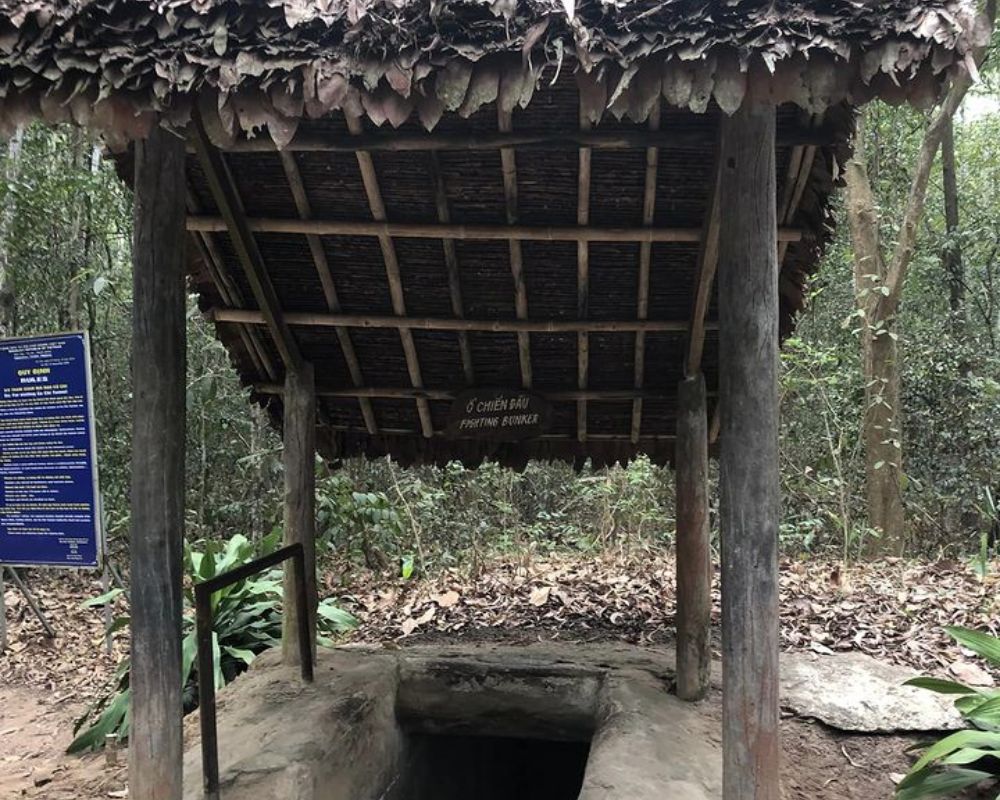
Battle nest
Over time, this underground network was expanded significantly during the Vietnam War, serving as a base of operations for the Viet Cong. The tunnels were used for military purposes and housed living quarters, storage facilities, and hospitals.
Origins and Development
The initial construction of the Cu Chi Tunnels began in the 1940s. These tunnels were simple at first, designed for shelter and basic transport.
The need for more sophisticated underground systems grew as the conflict with French forces intensified, leading to more extensive and complex tunnels.
Role in the Vietnam War
During the Vietnam War, the Cu Chi Tunnels played a crucial role in the Viet Cong’s strategy. These tunnels allowed them to move undetected, launch surprise attacks, and disappear quickly.
The tunnels had living spaces, kitchens, storage rooms, and hospitals, making them self-sustained communities.
Significance of Cu Chi Tunnels
The Cu Chi Tunnels are a symbol of Vietnamese ingenuity and resilience. They exemplify the resourcefulness of the Viet Cong in using the terrain to their advantage against a technologically superior enemy.
Today, they serve as a historical monument, educating visitors about the hardships and strategies of the Vietnamese soldiers.
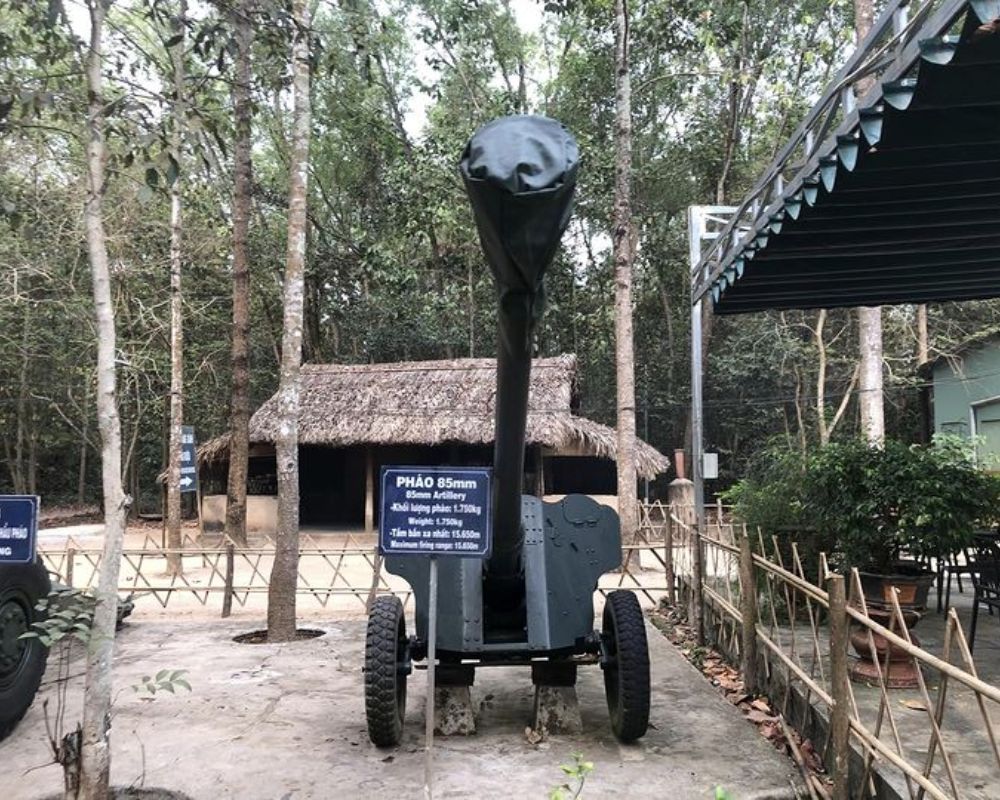
Canon
The tunnels were used to execute guerrilla tactics effectively. The Viet Cong used the tunnels for ambushes, booby traps, and to hide from aerial bombings.
These strategies were instrumental in their ability to control the rural areas surrounding Saigon (now Ho Chi Minh City).
The Structure of Cu Chi Tunnels
The Cu Chi Tunnels are a vast network spanning over 250 kilometers. The tunnels are narrow, with sections that have been widened for tourist access. They consist of multiple levels, including hidden entrances, booby traps, and living quarters.
Design and Construction
The tunnels were ingeniously designed to withstand bombings and enemy infiltration. They were dug using simple tools, and the soil from the tunnels was carefully disposed of to avoid detection. The entrances were well-camouflaged, and many were rigged with traps.
Key Features
Key features of the tunnels include trap doors, air ventilation systems, and water wells. Some sections also had areas specifically designed for meetings and planning attacks. These features highlight the meticulous planning and strategic importance of the tunnels.
Ben Dinh Tunnel Complex
Ben Dinh War Tunnels is one of the most visited sites within the Cu Chi Tunnel network. It offers a comprehensive view of the tunnel's structure and the life of the Viet Cong during the war.
Location and Highlights
About 50 kilometers northwest of Ho Chi Minh City, Ben Dinh War Tunnels is easily accessible for tourists.
Highlights include well-preserved sections of the tunnels, exhibits of wartime artifacts, and interactive experiences that allow visitors to crawl through the tunnels.
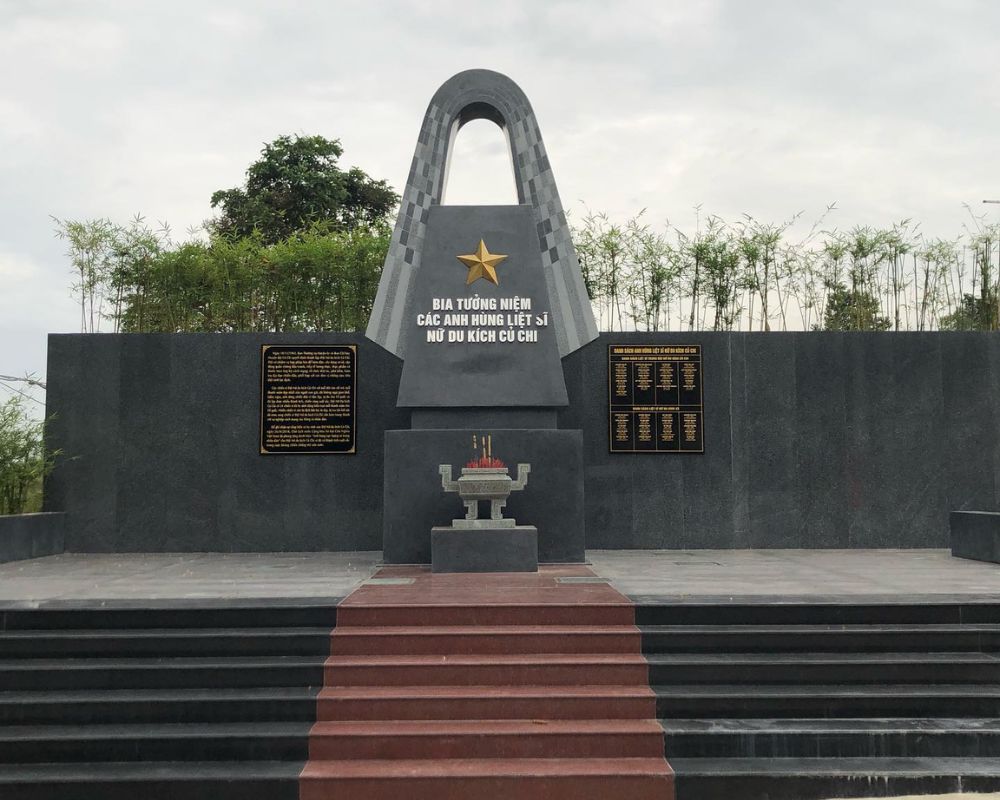
Memorial stele for heroic martyrs
Importance of Ben Dinh Tunnels
Ben Dinh Tunnels serves as an educational hub, providing visitors with detailed insights into the history and function of the tunnels. It is a key site for understanding the broader network of the Cu Chi Tunnels and their role in the Vietnam War.
Exhibits at Ben Dinh
Ben Dinh features several exhibits that offer deeper insights into the history and significance of the Cu Chi Tunnels. Displays include war relics such as weapons, uniforms, personal items, and tools used by the Viet Cong.
Models and dioramas illustrate various aspects of life in the tunnels, including living quarters, kitchens, and hospitals. Some exhibits are interactive, allowing visitors to engage more directly with the history and technology of the tunnels.
Detailed information panels provide background information on the tunnels, their construction, and their use during the war, while multimedia presentations offer engaging narratives about the history of the tunnels and the experiences of those who lived and fought in them.
Interactive Experiences at Ben Dinh
Ben Dinh offers a range of interactive experiences that allow visitors to engage more directly with the site’s history.
One of the highlights is the opportunity to crawl through sections of the tunnels that have been preserved or reconstructed, demonstrating the narrow, challenging conditions that soldiers endured.
Guided walks through the tunnels provide explanations of their construction and use, highlighting key features.
For an additional fee, visitors can experience the live firing range, where they can fire weapons from the era, such as AK-47s and M16s, under close supervision to ensure safety.
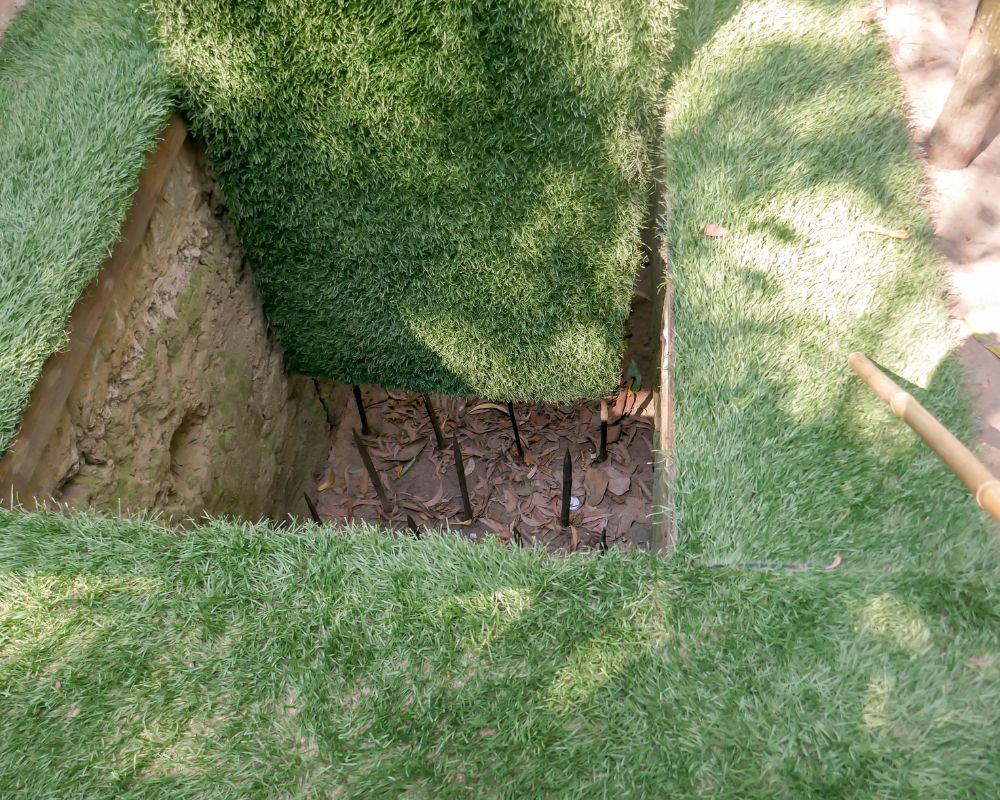
Steel spike trap at Cu Chi Tunnels in Vietnam
Other activities include trap demonstrations, where guides show how various booby traps used by the Viet Cong worked, and cooking demonstrations that reveal how soldiers prepared food in the tunnels using simple ingredients and methods.
How To Get From Ho Chi Minh to Ben Dinh, Cu Chi Tunnels?
Ben Dinh is accessible by various modes of transportation from Ho Chi Minh City, each offering different levels of convenience, comfort, and cost:
Ho Chi Minh to Ben Dinh By Bus
Regular buses run from Ho Chi Minh City to Bến Đình. This is an economical option, with tickets available at affordable prices. The journey typically takes 1.5 to 2 hours, depending on traffic conditions.
Buses can be caught from the central bus station in Ho Chi Minh City, and frequent schedules make this a convenient choice for budget travelers.
Two regular buses run from Ho Chi Minh City to Ben Dinh. It's Bus 13 and 79.
Departure Points:
- Ben Thanh Bus Station: Located in District 1, this is a major hub for bus routes in Ho Chi Minh City.
- Mien Tay Bus Station: Located in Binh Tan District, this station serves routes heading towards the Mekong Delta and surrounding areas.
You can download the BusMap app on the phone for iOS or Android to search for buses.
Ho Chi Minh to Ben Dinh By Taxi
Taking a taxi is another convenient option, providing a direct and comfortable ride. The taxi journey also takes approximately 2 to 3 hours. While more expensive than the bus, taxis offer the benefit of door-to-door service and the flexibility to travel at your own schedule.
Here is a list of popular taxi companies, along with their contact information and pricing:
|
Taxi Company
|
Phone Number
|
Base Fare (First 1 km)
|
Fare per km
|
|
Vinasun
|
(028) 38 27 27 27
|
12,000 VND
|
17,500 VND
|
|
Mai Linh
|
(028) 38 38 38 38
|
11,000 VND
|
16,000 VND
|
|
Saigon Taxi
|
(028) 38 23 23 23
|
10,000 VND
|
15,500 VND
|
|
Vinataxi
|
(028) 38 111 111
|
10,500 VND
|
15,500 VND
|
|
Future Taxi
|
(028) 38 71 71 71
|
10,500 VND
|
15,500 VND
|
Motorbike from Ho Chi Minh to Ben Dinh
For those seeking more adventure, renting a motorbikeis a popular choice. The ride to Ben Dinh on a motorbike takes around 1.5 to 2 hours. This method allows you to explore the countryside and make stops whenever you want.
However, it requires some experience handling Vietnam's traffic conditions and must motorbicycle license in Vietnam.
Here are some motorbike rental companies, including their contact details and pricing:
|
Rental Company
|
Phone Number
|
Daily Rental Price
|
|
Tigit Motorbikes
|
(028) 62 68 37 37
|
120,000 VND
|
|
Saigon Scooter Centre
|
(028) 38 20 62 22
|
150,000 VND
|
|
Flamingo Travel
|
(028) 39 26 02 79
|
130,000 VND
|
|
Rent A Bike Vietnam
|
(028) 39 14 13 27
|
140,000 VND
|
|
BikesBooking
|
+44 20 8133 0213
|
125,000 VND
|
Guided Tour
Many tour companies offer guided tours to Ben Dinh. These tours typically include round-trip transportation, a guided walk through the tunnels, and other activities. This is a hassle-free way to visit, as the tour company handles all logistics.
Tours can be booked online, through your hotel, or at local travel agencies in Ho Chi Minh City like Vietnam Budget Car Rental.
Guided tours often provide additional insights and historical context, enriching the overall experience. Read more: Cu Chi Tunnels And Ho Chi Minh Full Day Tour.
Ho Chi Minh to Ben Dinh By Car
Renting a car is a comfortable and flexible way to travel to Ben Dinh. The drive takes about 1.5 to 2 hours. Renting a car allows you to explore at your own pace and make stops at various points of interest.
One recommended option is Vietnam Budget Car Rental, known for its reliable service and competitive prices.
We offer a range of vehicles, from sedans to minivans, suitable for individual travelers and groups. Our fleet cars come with experienced drivers who are knowledgeable about the local area and can make your trip more convenient and enjoyable.
>>Read more: Private Car Rental With Driver Cu Chi Tunnels Full Day
Booking is simple and can be done via phone +84988038301, with competitive rates and transparent pricing. Whether you need car rental Ho Chi Minh for a day trip or a longer duration, Vietnam Budget Car Rental ensures a reliable and comfortable journey.
Best Time to Visit Ben Dinh at Cu Chi Tunnels
The best time to visit Cu Chi Tunnels is during the dry season, from November to April. During this period, the weather is more predictable, with less rain and cooler temperatures, making it more comfortable for exploring the tunnels.
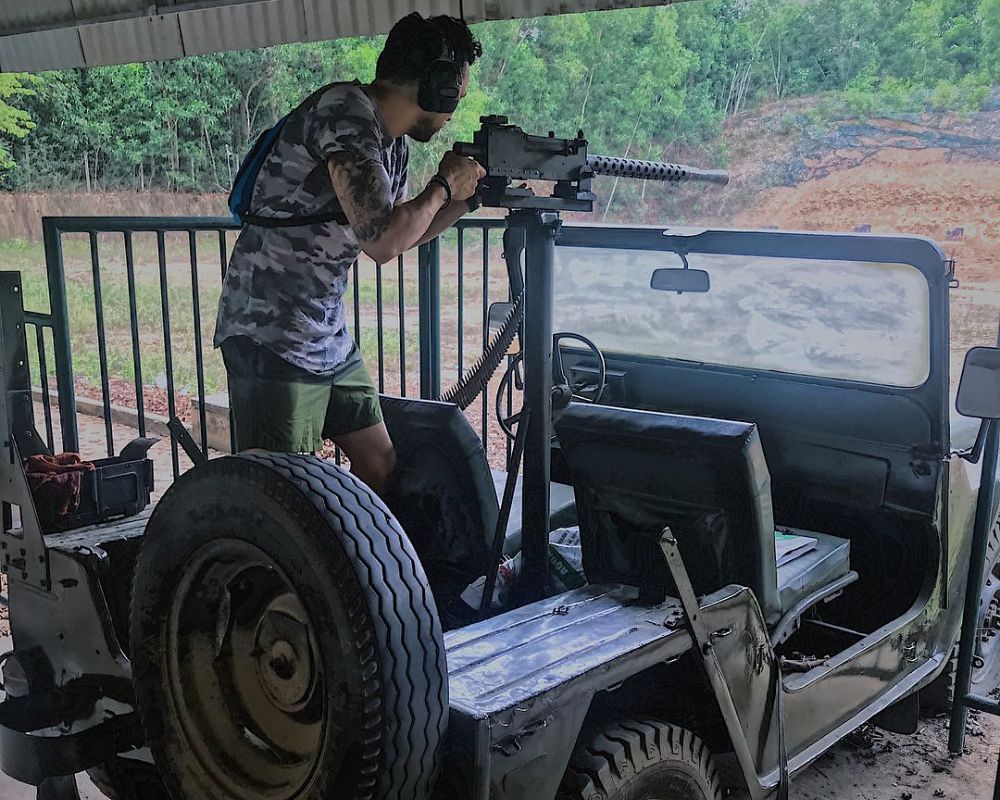
Best time to visit Cu Chi Tunnels is from November to April
Visiting in the morning is recommended to avoid the midday heat and larger crowds. Arriving early also lets you enjoy the site before it becomes too busy.
The cooler morning temperatures make the experience more pleasant, especially when navigating the narrow, underground passages.
Safety Tips for Exploring Cu Chi Tunnels
While exploring the Cu Chi Tunnels, keeping safety in mind is important. Wearing appropriate clothing, such as comfortable, breathable attire and sturdy footwear, is recommended due to the narrow and humid conditions in the tunnels.
Staying hydrated is crucial, especially if visiting during the hotter months, so bring water, as there are usually facilities to buy drinks on-site.
The tunnels can be physically demanding, particularly for those with mobility issues, so it’s important to check with your guide about which sections are more accessible.
The narrow, dark spaces may also be challenging for those with claustrophobia, so informing your guide of any concerns is advisable.
Additionally, bring mosquito repellent to protect against bites, and consider carrying a small personal first aid kit.
